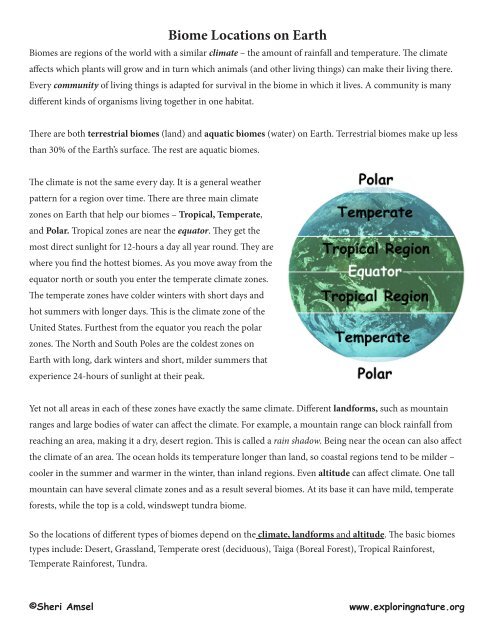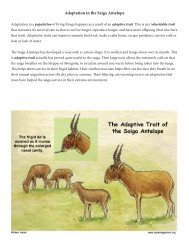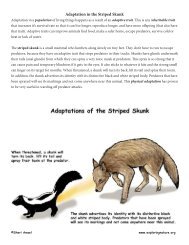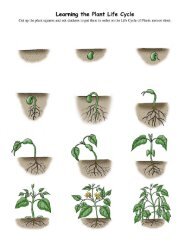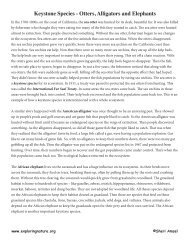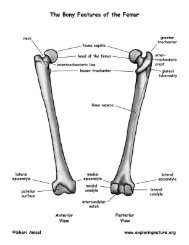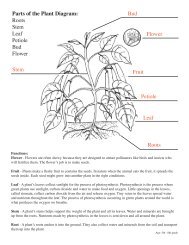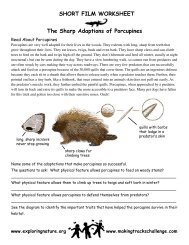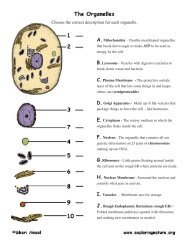Biome Locations on Earth - Exploring Nature
Biome Locations on Earth - Exploring Nature
Biome Locations on Earth - Exploring Nature
Create successful ePaper yourself
Turn your PDF publications into a flip-book with our unique Google optimized e-Paper software.
<str<strong>on</strong>g>Biome</str<strong>on</strong>g> <str<strong>on</strong>g>Locati<strong>on</strong>s</str<strong>on</strong>g> <strong>on</strong> <strong>Earth</strong><br />
<str<strong>on</strong>g>Biome</str<strong>on</strong>g>s are regi<strong>on</strong>s of the world with a similar climate – the amount of rainfall and temperature. The climate<br />
affects which plants will grow and in turn which animals (and other living things) can make their living there.<br />
Every community of living things is adapted for survival in the biome in which it lives. A community is many<br />
different kinds of organisms living together in <strong>on</strong>e habitat.<br />
There are both terrestrial biomes (land) and aquatic biomes (water) <strong>on</strong> <strong>Earth</strong>. Terrestrial biomes make up less<br />
than 30% of the <strong>Earth</strong>’s surface. The rest are aquatic biomes.<br />
The climate is not the same every day. It is a general weather<br />
pattern for a regi<strong>on</strong> over time. There are three main climate<br />
z<strong>on</strong>es <strong>on</strong> <strong>Earth</strong> that help our biomes – Tropical, Temperate,<br />
and Polar. Tropical z<strong>on</strong>es are near the equator. They get the<br />
most direct sunlight for 12-hours a day all year round. They are<br />
where you find the hottest biomes. As you move away from the<br />
equator north or south you enter the temperate climate z<strong>on</strong>es.<br />
The temperate z<strong>on</strong>es have colder winters with short days and<br />
hot summers with l<strong>on</strong>ger days. This is the climate z<strong>on</strong>e of the<br />
United States. Furthest from the equator you reach the polar<br />
z<strong>on</strong>es. The North and South Poles are the coldest z<strong>on</strong>es <strong>on</strong><br />
<strong>Earth</strong> with l<strong>on</strong>g, dark winters and short, milder summers that<br />
experience 24-hours of sunlight at their peak.<br />
Yet not all areas in each of these z<strong>on</strong>es have exactly the same climate. Different landforms, such as mountain<br />
ranges and large bodies of water can affect the climate. For example, a mountain range can block rainfall from<br />
reaching an area, making it a dry, desert regi<strong>on</strong>. This is called a rain shadow. Being near the ocean can also affect<br />
the climate of an area. The ocean holds its temperature l<strong>on</strong>ger than land, so coastal regi<strong>on</strong>s tend to be milder –<br />
cooler in the summer and warmer in the winter, than inland regi<strong>on</strong>s. Even altitude can affect climate. One tall<br />
mountain can have several climate z<strong>on</strong>es and as a result several biomes. At its base it can have mild, temperate<br />
forests, while the top is a cold, windswept tundra biome.<br />
So the locati<strong>on</strong>s of different types of biomes depend <strong>on</strong> the climate, landforms and altitude. The basic biomes<br />
types include: Desert, Grassland, Temperate orest (deciduous), Taiga (Boreal Forest), Tropical Rainforest,<br />
Temperate Rainforest, Tundra.<br />
©Sheri Amsel<br />
www.exploringnature.org
A more in depth look shows us there are closer to 12 major biomes:<br />
Arctic Tundra<br />
Boreal Forest (Taiga)<br />
Temperate Deciduous Forest<br />
Temperate Grasslands<br />
Dry Woodlands and Shrublands (Chaparral)<br />
Desert<br />
Tropical Rainforest<br />
Tropical Deciduous Forest<br />
Tropical Scrubland<br />
Tropical Savanna<br />
Semidesert/Arid Grassland<br />
Polar Ice<br />
Mountains (In each of the above)<br />
Look at the chart below to see how climate - rainfall and temperature affects where each biome is located.<br />
©Sheri Amsel<br />
www.exploringnature.org
Answer the questi<strong>on</strong>s to understand how climate - rainfall and temperature affects where each biome is located.<br />
1. Looking at this chart, you can see that the hotest regi<strong>on</strong>s (bottom row) have many biomes types depending<br />
up<strong>on</strong> the amount of rainfall. Can you list from the most rainfall (wettest) to the least rainfall (driest) what kinds<br />
of biomes you would find in this hottest regi<strong>on</strong>?___________________________________________________<br />
_________________________________________________________________________________________<br />
2. The regi<strong>on</strong>s with the most rainfall (wettest) have the richest plant life (left side). Looking at the chart, can you<br />
name the these richest biomes going from the hottest locati<strong>on</strong>s to the coldest? ___________________________<br />
_________________________________________________________________________________________<br />
3. Where might you find the “tropical desert” as seen <strong>on</strong> the chart?____________________________________<br />
4. Where might you find the coldest desert as seen <strong>on</strong> the chart? ______________________________________<br />
©Sheri Amsel<br />
www.exploringnature.org
©Sheri Amsel www.exploringnature.org


